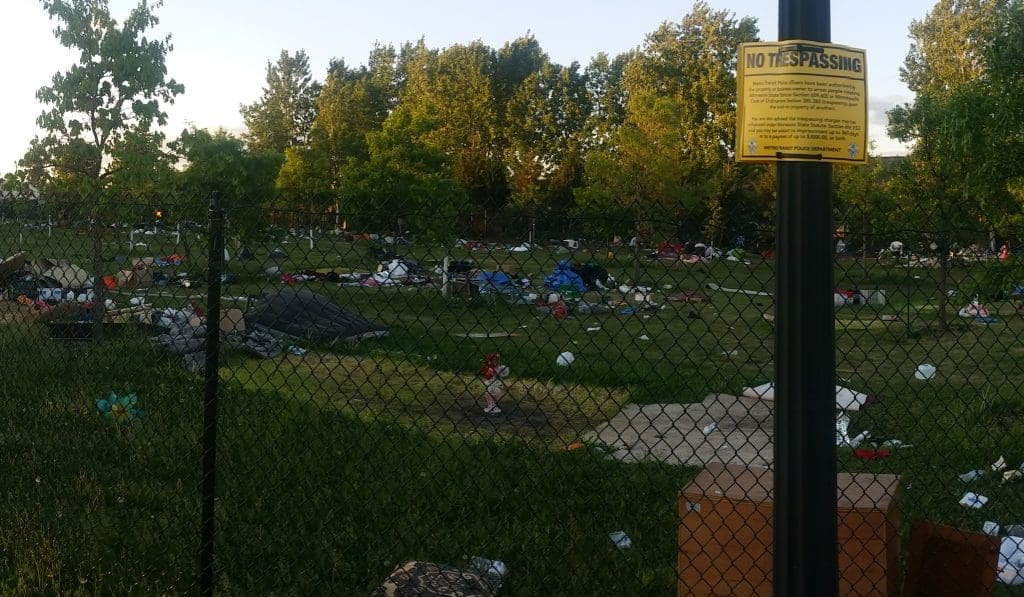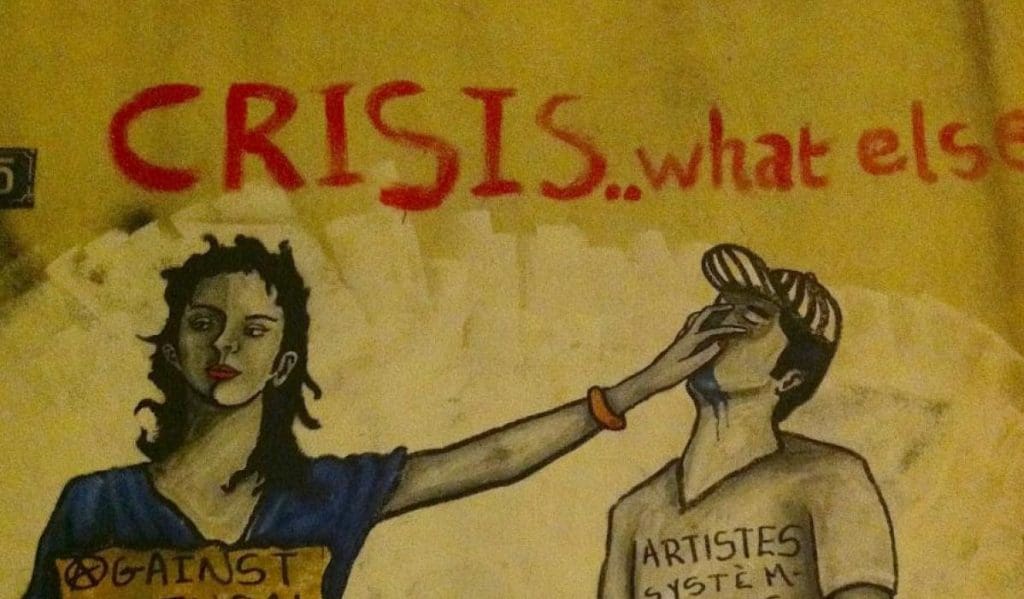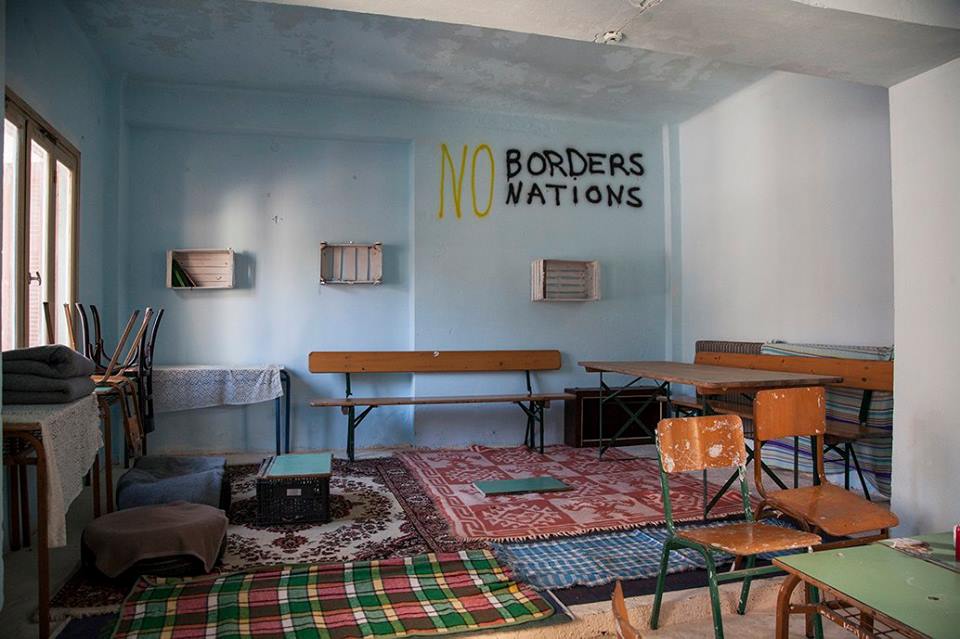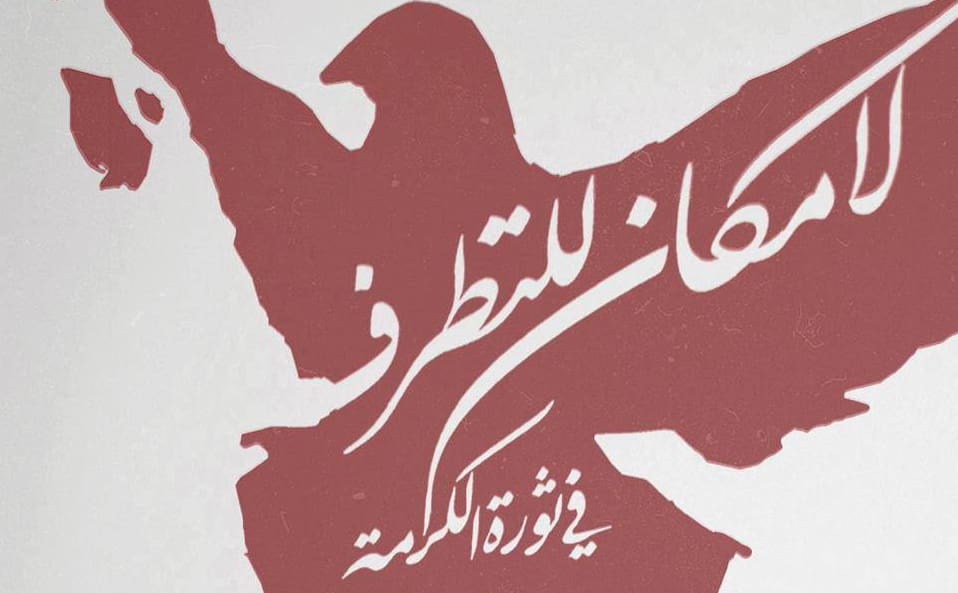AntiNote: With gratitude for the author’s kind permission, we reproduce here a street-level snapshot of the struggle in Minneapolis for housing, health, and dignity that flew into high gear alongside the George Floyd uprisings over the summer of 2020, known at the time colloquially as the Sanctuary movement.
It goes without saying that this struggle was already ongoing before this narrative picks up, and continues today, over a year since the brief takeover of the Sheraton Hotel on East Lake Street. But the ways that mutual aid and resistance projects among the dispossessed and racialized poor and working class in south Minneapolis intertwined with the forceful confrontations with the state over police violence during this period of apparently open possibilities were particularly inspiring, intense, and complex.
It will take many years and many more testimonies like this from folks on the ground to get the full picture of everything people were doing to survive and assert their humanity together amid escalating police repression and a global pandemic during the long hot summer of 2020. This modest but forceful witness is as good a place as any to start.
The Best City for Public Parks, and One Thousand People with Nowhere to Sleep
by Yusra Murad
8 June 2021 (original post)
This is not a story with a point, or a story about things that happened and how they made anyone feel, or really a story at all. It is just telling you a few details about how, precisely, the city of Minneapolis and state of Minnesota cemented criminalization as their only response to an ongoing housing crisis from May through August 2020, during a pandemic, because it is still going on, and whoever wants to know should be able to know. It is not exhaustive, because I didn’t include anything I didn’t witness or talk with someone about with my voice or hands. It is not anyone’s experience or a call to action. I am just telling you what I saw. I do feel all kinds of ways, but I’ll figure out what to do about that as I go.
Fact: dignified housing for all is a contradiction to the police state.
From the Share-A-Ton to Powderhorn
On 30 May 2020, a hotel became: a site of occupation, an unapologetic demand to reject all rules governing space, a pantry, a kitchen, a community health clinic, a home, twenty homes, two hundred homes, an indictment of every sitting elected official, and a swift rejection of the callous lie that they are the arbiters and keepers of justice, 1.3 miles from a humiliated police precinct. Others have written about the Sanctuary Hotel already, and if you’ve read it or if you were there then you know that by 10 June, the Hotel in all its imperfection ceased to become anything more or less than what it was. The matter of the decline-to-comment, deactivated-key-cards-en-masse owner of the hotel, does matter, but I won’t get into it here.
So on 10 June, a Minnesotan without a house—their name is not your business, but they deserve to be called by theirs, so let’s settle with R.—pitched the first tent at Powderhorn Park, the day after the Minneapolis Police Department had descended on the Hotel. R. and another 150–200 sheltered unhoused people were, once again, unsheltered unhoused people, once again displaced with nowhere to go.
And then Powderhorn became home to many homes, beginning with forty or fifty tents and soon ten times that many. Clearly people did not just “appear,” as the New York Times would describe a few weeks later, unless we’re talking about the literal tents, which no one should be, because a tent is a tent. The residents of the encampment had come from the Hotel, from Lake and Hiawatha, from under the bridges and the lightrail, and the city of Minneapolis has long known exactly who and where unsheltered people are, because they can find them when the handcuffs are out in less time than it takes you to read this. More importantly, the tents were staked in violent conditions that have facilitated a decades-long housing crisis in a city where white supremacy never, ever yields. The New York Times should correct this error, but a lot of people should do a lot of things they don’t do.
Two days later, in the early hours of Friday, 12 June, the Minneapolis Park Police arrived at Powderhorn clutching eviction notices, entering homes and demanding residents leave the premises by 8 a.m. (the choice to serve eviction notices instead of, say, trespassing notices, is not a small detail, because it would be difficult to serve an eviction without acknowledging the presence of a home, I’m sure you’d agree). By sunset, pressure from neighbors, community outrage, and a digital campaign swiftly reversed the eviction. Governor Tim Walz’s staff allegedly began convening the Interagency Council on Homelessness to help acquire resources for residents at Powderhorn (many things happened quickly after that; resources from the Interagency Council markedly absent from that list).
By 16 June, Fuck 12 People’s Kitchen was undefeatable and indefatigable. Over the course of the next month, F12 would go on to serve six meals a week for both sides of Powderhorn Park.
I don’t have an editor hounding me about word count here so let me insert my sidebars wherever I please, as soon as I can. Fact: F12 fed and nourished and sustained a movement. Fact: F12 mobilized meal service for over a hundred unhoused residents faster than the City of Minneapolis could figure out how to open access to a fire hydrant across the street so people could have some goddamn water (seventy-two hours, for reference).
The next day, 17 June, the Minneapolis Park Board passed what was ostensibly a historic resolution, permitting all parks to serve as refuge sites for unsheltered people. It would not last a month; of course no one knew this. Maybe it wouldn’t have mattered if we did.
By this point there were something like fifty volunteers and community members and neighbors cycling in and out of Powderhorn Park every single day, in four- or eight- or twelve-hour shifts, counting silverware in the food tent, working as community safety patrol, wrapping wounds, managing the shower stall, lifting plastic from the grass, organizing outreach workers, tossing a frisbee, or sitting cross-legged, carefully placing little flowers in the divot of a fallen leaf, a bouquet wrapped with a blade of grass. There was a sign-up sheet, and volunteer orientation (“Shared Values: AUTONOMY AND RADICAL EMPATHY; HARM REDUCTION; MUTUAL AID; ABOLITION; ANTI-RACISM”), meetings in the parched afternoons and an open mic at sundown, and a great deal of hope, even when the rain passed over and soaked boxes of honey-nut cheerios all the way through.
State and NGO gymnastics
Over about two weeks, somewhere in there, every outreach team in the Twin Cities flocked onsite. Most outreach workers are kind and exhausted; only some are cold and cynical; all have supervisors that believe the state can manage/sort-and-filter/export-to-csv its way out of homelessness, shuffling people between shelters and systems of enforced poverty.
One of the largest homeless outreach organizations in the region had a contract with the state to conduct a “census” of Powderhorn, apparently in an effort to decipher the scale of the response that was needed. The census cost a couple thousand if I remember correct. Some might argue that three hundred tents surrounding the lake could indicate something like “Hey, maybe the response is to get every single person into every vacant unit or hotel room within twenty miles.” Others might not argue, but just wonder if there was one (1) demonstrable benefit of using that money on a census versus direct cash payments, getting people phones, paying some security deposits, hotel rooms, birth certificates, I don’t know, any ideas?
At this point, Hennepin County had convened “Powderhorn Incident Response” meetings, including officials from the Office to End Homelessness, the Minneapolis Police Department, the Park Board, the Health Department, and the state of Minnesota. People living at or supporting Powderhorn were, you’ll be shocked, not invited. After some pressure, they caved—by which I mean they made a new meeting for the sole purpose of keeping their The Adults Are Talking, Honey meeting private.
On 24 June, these “Powderhorn Coordination” meetings began. The purpose was, apparently, “to discuss updates from each agency and assign action steps.” These “updates” would turn out to be a remarkable demonstration of the Simone-Biles-level mental gymnastics it requires to avoid the words “permanent housing” in a conversation about several thousand people lacking permanent housing.
At this time, the following asks were made in writing, so no one could ever say they hadn’t heard them, to:
Minnesota state house representative Aisha Gomez, city council member Alondra Cano; Hennepin County commissioner Angela Conley; mayor Jacob Frey; Minneapolis Parks and Recreation Board [MPRB] commissioner Londel French; Minnesota housing commissioner Jennifer Ho; state senator Jeff Hayden; Don Ryan of Hennepin County’s Office to Prevent Homelessness; Lt. Grant Snyder of the Minneapolis Police Department; MPRB staff member Jenna Tuma; and Minneapolis Health Department deputy commissioner Noya Woodrich:
- No moving anyone without their consent, and only relocating if you are providing/resourcing a better option
- Large tents so all the food and supplies don’t get wet and so folks can dry their stuff off
- A shower for the east side of Powderhorn Park (the shower on West was provided by a Jewish disaster relief organization)
- Electrical connection so volunteers do not have to run generators
- Drinking water stations that balance COVID-19 safety with the need for potable drinking water
- Willingness to fund a trusted and accepted partner to operationalize centralized Sanctuary coordination
- Scaling up paying for and activating hotel rooms to house people
- Funding the purchase of hotels to use as housing (specifically the former Sheraton, to be operated by a culturally relevant organization)
- All park, city, county, and state property and funds to be prioritized for housing people experiencing homelessness
By late June, as residents of Powderhorn began seeking smaller spaces, sheltered and unsheltered neighbors began resourcing a “satellite” encampment at Lyndale Farmstead, and community members engaged with Powderhorn began directing more energy and resources toward Peavey Park, the Greenway, and other encampments across Minneapolis.
Important context I missed earlier: the state had something like $55 million from the CARES Act to support unhoused people during the pandemic. $55 million is what you would have today if I gave you $2,000 a month starting before the birth of Christ. Sometimes we get desensitized to words like “millions” and lower our expectations. You know? So just keep that in mind.
Scattering in anxious slow motion
On 1 July, the MPRB introduced Resolution 2020–263, calling for all encampments to be reduced to ten tents at ten parks total—who wants to help me fit a Boeing 747 into a U-Haul? Following a day-long email campaign culminating in a rally at MPRB headquarters, the resolution was tabled until 15 July, hardly a favor, as building an environment of perpetual fear and ticking clocks and bulldozers rolling one foot at a time is a foolproof strategy for physically and psychologically exhausting anyone to the point of being unable to think beyond the next morning.
By 2 July, Kingfield and Martin Luther King satellite parks were established. That day, councilmember Cano’s office sent out an advisory for a July 6 “Powderhorn Partners” meeting, composed of:
“Four unhoused residents; four housed residents; the Powderhorn Park Neighborhood Association [PPNA]; representatives from each of the non-profits hired to service the camp such as Avivo, St. Stephen’s, and any others with active contracts and presence on site; MPRB; Minneapolis mayor Jacob Frey; Cano and city staff; commissioner Angela Conley and county staff; state rep. Gomez; state senator Hayden; lieutenant governor Peggy Flanagan and state staff.”
The event was put on “hold” as promptly as it was organized, and never rescheduled.
Come 13 July, Kenwood, Brackett, Minnehaha, Riverside, and Annie Young Meadow were established as Sanctuary sites, and two weeks have slipped like smoke through an open palm; that previously tabled resolution is a hissing flame. The revised resolution proposed twenty-five tents at twenty “permitted” parks, as if there is any such thing as a “permissible” encampment in a city saturated with vacant public housing units and public land, and empty lots and hotels collecting dust, and $55 million!
That Monday, 13 July, MPRB President Jono Cowgill was urged against a “permitting” system that was destined to fail (the suggestion on its own inherently implicating the numerous failures preceding it); creating a dangerous hierarchy between permitted and non-permitted encampments; and writing into law justification for park evictions. Where’s the governor in all this, you have to wonder — was it not his signature on an executive order barring all evictions (including encampments) during the peacetime emergency?
The next day, as the board was allegedly marinating on the resolution—or more likely drafting up contracts that would soon be necessary to bulldoze and trash neighborhoods—F12 began meal distribution at Brackett, Lyndale Farmstead, Kenwood, and Martin Luther King, plus 150 meals to Powderhorn East and West. Meanwhile, volunteers opened up a supply depot at a Minneapolis church that would go on to distribute food, water, clothes, and other essential items across twenty-some parks—an ongoing operation still in 2021, because some people in this city care whether their neighbors can live and eat and sleep at night.
An aside: I am not going to say much about the details of this mutual aid work because my goal here is to convey the extent to which the city brazenly failed to support homeless people during a pandemic, and by getting into the mutual aid work I risk glossing over the racist, misogynistic, white savior behavior that swallowed so much of it whole. Just putting it in the record in case anyone tries to argue the city did any of that work. They didn’t.
Back to 14 July: city, state and county officials informed volunteers and residents at Powderhorn of their plan to move residents out of the park and “to housing or shelter,” announcing they had secured transportation via the state to assist in these moves. The email chain was in its infancy before it became clear that the “transition” was not, in fact, from Powderhorn to housing, but rather from Powderhorn to other parks. Always crisis and confusion and words that mean another word.
It’s admittedly hard for me to envision a world in which these officials were somehow unaware the satellite encampments would again come under the threat of eviction within twenty-four hours, by their own colleagues, but, you know, maybe you have a more generous imagination than I do. I doubt it. Whatever.
The next day, MPRB voted to reduce the size of encampments to twenty-five tents at twenty parks with permits, vowing a list of “designated” sites. Some protested at the park board, others began crowdfunding for hundreds of hygiene kits (again: $55 million) and organizing de-escalation trainings, and maybe you’ve picked up on a trend—visible across Minneapolis—of community digging their heels in at precisely the same moment government shamelessly dragged barricades out from the trenches.
The carousel keeps turning
By 17 July, Logan Park, Loring Park, Elliot Park, Marshall Terrace, Peavey, and The Mall were established sites. MPRB updated their website to say Lake Harriet had space for twenty tents and Marshall Terrace for nineteen—this is important—and deemed Brackett, Elliot, Kenwood, Lyndale Farmstead, Peavey and Powderhorn West “full,” whatever that meant (actually what it meant was: one more tent and we’ll have grounds to evict and send residents to other parks, which will also become full, and then we’ll have grounds to evict and send residents to other parks, which will…).
When should I add that, according to MPRB’s system for counting tents, tents holding food and supply counted the same as tents housing people? Does that work here?
On 17 July, board superintendent Al Bangoura issued an eviction notice—delivered under the authority of the police—to East Powderhorn, demanding everyone leave before the board engaged law enforcement (that was a relief; when he sent the eviction notice under the authority of law enforcement, for a moment I worried law enforcement was already engaged). No list of alternate parks was provided, despite the promise two days prior.
A reminder that the only publicly shared information at this point was that there were twenty and nineteen openings at Harriet and Marshall Terrace, respectively. MPRB staff said not to worry, Logan Park had fourteen openings, bringing the grand total to fifty-three “spots” for (my best guess) 250 people. MPRB also denied requests for bathrooms and handwashing stations at Lake Nokomis, arguing Nokomis was not a “designated site” (still no list) but of course Nokomis is established anyway because where, precisely, are people supposed to go.
Around 1 p.m. on 20 July, MPRB, Park Police, and MPD arrived at Powderhorn East. State officials followed, peeled themselves up from bus seats drenched in sweat, a field trip to hell, to chauffeur newly displaced residents to a handful of other parks. Dead, soulless eyes you get only when you’re doing something vile that you’ve done before and know you’ll do again. Twenty community members, including an Indigenous woman, were arrested onsite for protecting land. State officials indirectly provided a short list of open and “potentially approvable” sites, but the list was still not public, and park staff did not respond to a request for one.
The next week dripped into the heat. A portion of the displaced residents of East Powderhorn pitched tents at established encampments across the city, others set up at Bryn Mawr.
The grind keeps grinding
On July 25th, a group of almost 200 marched to mayor Frey’s apartment, demanding he show his face and discuss any of the dozen ideas community had brought forth, and I suspect he sat there, cheek muscles incarcerated in a charcoal mask.
A few miles away, Beltrami Park residents and neighbors pled with park staff, requesting port-a-potties and a handwashing station for a group of ten Native elders. Denied. “They can move to an encampment that is set up with services,” read an email two days later. “Beltrami doesn’t have service set up. If they want it to be considered they should go the permit route.”
Beltrami is established anyway because where, precisely, are people supposed to go.
Powderhorn East was scrubbed of all memory by 27 July, though a visitor to the city may have wondered about the stark orange netting draped over the playground, and shiny metal signs (“NO OVERNIGHT ACTIVITY OR CAMPING ALLOWED AT THIS LOCATION This is not an authorized encampment site”). That afternoon, White Earth Nation chairman Mike Fairbanks, president Larsen of the Lower Sioux Community, Park Board commissioner Londel French, rep. Gomez and council member Cam Gordon gathered in a half-moon to speak at a press conference, committing to do what they could to ensure no more violent evictions.
A note that Londel French and rep. Gomez in particular showed up, many times, all the time, not to speak or to listen but just to do whatever was required; and it’s sad to me, still, that our cry and theirs was reduced to “do not evict encampments.” Because of course do not evict encampments — and — no one who wants to live inside should be living outside in a state with the resources to house everybody in the first place. Withholding and gatekeeping those resources behind a barbed wire fence of housing lists and subsidy requirements and professional statements of need is a criminal act and human rights violation and that’s not up for debate.
The next day, MPRB issued a permit for Lake Harriet, allowing fifteen tents total, including those already there. Not twelve days prior, the board’s own website had stated Harriet had space for twenty.
On 31 July, MPRB served “Notices of Transition” to Powderhorn West, citing “safety concerns” and “location within a safe school zone.” The Notice of Transition set no deadline for complete removal (“next couple of days”) and offered other parks until cold weather makes it untenable for camping, and then limited shelter, as the solution for residents. Even the most generous definition of transition implies moving from one state or condition to another. Not moving from one state or condition to nothing.
It’s wise to keep in mind these were residents who watched, from across the bowl: police shoveling tents into the gaping mouths of industrial dumpsters, sending people either to jail or to another park, guns on their waist; and it becomes easier to understand why a “couple days” didn’t really bring the peace.
That same day, MPRB denied a permit for Brackett Park — the only park established for exclusively women and children, with services, security, and support specific to their needs — because it was a school zone, never mind school was not in session, never mind the putrid philosophy underpinning the argument that school children should never bear direct witness to a crisis of unsheltered homelessness, never mind that school children can also be unsheltered, never mind that their mothers are not receiving any more assistance from the state than they were thirty years ago.
And then come the sweeps
On Monday, 3 August, residents held a press conference at Powderhorn West to demand their right to autonomy, and MPRB said, “We’re not evicting you now, we’re just threatening to remove you soon, not sure when,” and everyone was like, “Oh, well, in that case!”
MPRB also issued a permit for Marshall Terrace that day, for fifteen tents total, despite earlier communication that Marshall Terrace had space for nineteen, another honest mistake.
The next day, land “owned” by the Community Planning & Economic Development agency at 26th Street & 14th Avenue was fenced off.
On 7 August, MPRB finally shared their list of parks “capable of accommodating encampments”: Annie Young Meadow*, Beltrami*, B.F. Nelson, Boom Island, Bryn Mawr, Franklin Steele, Nokomis, Logan*, Lyndale Farmstead*, Minnehaha*, MLK*, Riverside*. Those with asterisks were “full” by the time the list was posted. At that point, there were permits only for Harriet, Marshall Terrace, and the Mall, so every other park on that list remained subject to clearing.
That day, the Park Board sent staff to Peavey Park to announce they would return the following week with buses, to clear the space and move residents to Franklin Steele.
On 8 August, Loring Park received forty-eight-hour eviction notices.
Three days later, 11 August, Kenwood, Elliot, and Peavey got theirs. No deadline.
MPRB updated its website the morning of 12 August: “These notices are not the same as the incremental approach at Powderhorn.” (INCREMENTAL?) “MPRB has advised people to move immediately.” Of course law enforcement is the “last strategy,” and of course that day, cops showed up at Kenwood and Peavey.
One bulldozer and seven cops at Kenwood, with an MPRB commissioner who did not answer questions about the eviction notice being vague and without a specific time frame, and told volunteers that it simply was not a designated park. According to the cops, the language “eviction” was misleading; parks aren’t leased. Exactly. Exactly.
On 13 August, Bryant Square Park, forty-eight hours.
On 14 August, Loring, again.
At 8 a.m. on 14 August, Powderhorn West residents woke up to police unzipping their tents, the second and last time.
The “Notices of Transition” were, at that point, two weeks old, and no one had heard anything. Bulldozers mangled every standing tent and police arrested three people, barking at one resident—for requesting extra time to pack their belongings—to get behind the tape or get in handcuffs. They lost the only photos of their family they had in their possession.
A few miles away, the city swept Peavey. At this point, not one permitted encampment had space. Some people moved to Logan, some to Beltrami, some to the Wall of Forgotten Natives.
Four days later, 18 August, Bryn Mawr residents got their forty-eight-hour notices. And Loring, again. The next day, ten Beltrami residents moved to Edgewater (smaller encampments, wasn’t that the point?). Police at Edgewater within fifteen hours of establishment, evicted, back to Beltrami.
On 21 August, Loring, it happened that time, evicted, swept, like it never happened.
Volunteers assisted residents in moving to Columbia Park. Across the river, officers informed Camp Kellogg they would receive an eviction notice on 24 August. A notice of eviction notice. The clown show continues.
On 22 August, Columbia was evicted, in the depth of the night. Residents were loaded into buses and dropped off at BF Nelson. A couple hours later, police hand out eviction notices with no timestamp at Matthews Park.
F12, through it all, was coordinating distribution at parks, plus a couple hotels, and keeping pace with the moves and evictions and moves, making 250 meals, Tuesday-Sunday, for between twelve and fifteen parks.
That was a lot. It’s always a lot, but August was something else.
The City of Lakes, so pure and cruel
The thing about the Park Board. It’s definitely true, what they said—that the board was not built to address unsheltered homelessness—but no one is, so everyone is, and the least they could’ve done is not make it so much more painful. It will take a lot of data requests to learn who in the city council was pressuring MPRB, and which predatory real estate companies and developers foaming at the mouth to gentrify every block of Minneapolis were pressuring those council members. In the absence of what should be transparent, public information, it’s safe to assume: every last god damn one.
This writing is as of March 2021. Since August 2020, Jacob Frey, the City of Minneapolis, the Hennepin County Board of Commissioners, the Minneapolis Police Department, Minneapolis Park Police, CPED, Hennepin County Railroad Authority, and Hennepin County Sheriffs have either authorized or conducted a sweep of nearly every single encampment, be it in a lot, an underpass, or a park. Governor Tim Walz, the Minnesota Office to Prevent and End Homelessness, and nearly every member of the state legislative body (save for rep. Aisha Gomez) have said nothing.
The violent and abusive attempt by MPD to clear Near North on 18 March was technically unsuccessful, but it depends on how you measure. We still fund a police department salivating from the teeth to disrupt, disturb, damage, or destroy community spaces, be it at Near North or George Floyd Square. Trauma compounds and builds upon itself like a beast. Minnesota is one of the fifteen states witnessing an uptick in COVID infections, at the time of this writing, and deployed twenty squad cars for an encampment of twenty people faster than they could mobilize additional vaccine opportunities. This is where we are. This is what we are dislodging ourselves from.
“Whatever it is, coronavirus has made the mighty kneel and brought the world to a halt like nothing else could. Our minds are still racing back and forth, longing for a return to ‘normality,’ trying to stitch our future to our past and refusing to acknowledge the rupture. But the rupture exists. And in the midst of this terrible despair, it offers us a chance to rethink the doomsday machine we have built for ourselves. Nothing could be worse than a return to normality.
Historically, pandemics have forced humans to break with the past and imagine their world anew. This one is no different. It is a portal, a gateway between one world and the next.
We can choose to walk through it, dragging the carcasses of our prejudice and hatred, our avarice, our data banks and dead ideas, our dead rivers and smoky skies behind us. Or we can walk through lightly, with little luggage, ready to imagine another world. And ready to fight for it.”
— Arundhati Roy, “The Pandemic is a Portal”
* * *
Featured image: the ghosts of a freshly cleared encampment. 28th Street and Hiawatha Avenue in south Minneapolis on 29 May 2020, the day after the Third Precinct burned just half a mile away. Photo: Ned Flowers





